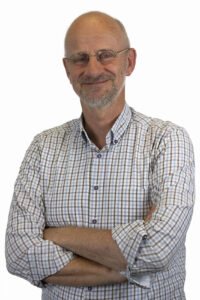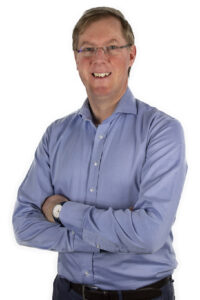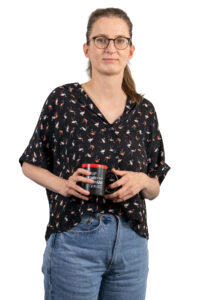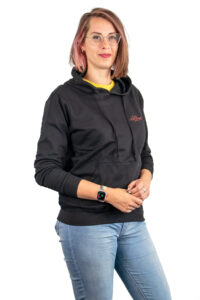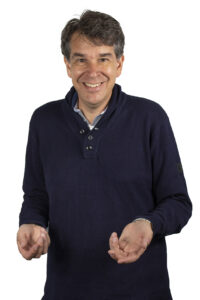As an institute, Nikhef intends to be climate neutral by 2030. The ‘Sustainable Nikhef Roadmap’ details how the institute intends to achieve this ambition along the five lines of travel, energy for the building, waste, behaviour and environmental impact of research.
A new carbon footprint study for 2022 now shows that a number of important steps have already been taken. For example, Nikhef employees now fly less compared to before corona. And other sources of CO emissions have also started to decline.
Institute manager Arjen van Rijn and Nikhef sustainability ambassadors Jan Visser, Maria Haney, Catharina Vaendel and Patrick Koppenburg explain what other actions have already been taken. And what plans and ideas are in the pipeline for the coming years.
__________________________________
Arjen van Rijn – our footprint
“We just received Nikhef’s new carbon footprint analysis, done for us by Arcadis, a sustainability consulting firm. It actually made me happy. What we see is that in 2022 the item air travel is significantly lower than in 2019, before corona. That means that although we have started to travel again, we still fly less than before. Partly because we travel less and work more online, partly because we travel differently – like taking the train more often. But the trend is down, and that’s good. Nikhef wants to be basically CO2 neutral by 2030. That’s really still a challenge, by the way. What will certainly help is that after the renovation of the main building in Amsterdam, we will be almost completely off the gas grid. All the heat we need will then come from the data center, which, by the way, has also been heating the student housing in the neighborhood for almost 10 years. The power for the data center and the building is basically green, generated in the Netherlands. For cooling of our offices and clean rooms, after the renovation we are connected to a system of underground thermal storage; that is a sustainable form of cold generation. In principle, the building is also prepared for the installation of solar panels on the roofs. That provides two things. Green power. And a clear signal that Nikhef takes sustainability seriously. I find it gratifying how normal the conversation about sustainability is starting to become, certainly also due to the actions of young employees who take it for granted.”
Arjen van Rijn is institute manager of Nikhef, and on the Nikhef management team he is responsible for the institute’s sustainability policy.
__________________________________
“Travel is and remains the largest item in Nikhef’s carbon footprint, especially flying, which can produce ten times more emissions than the train. Unfortunately, this is partly unavoidable. We work internationally, so we will continue to travel. But with much more policy than in the past. Back then you flew to CERN ten times a year, sometimes even back and forth on the same day. We really don’t want that anymore. But we are not going to ban anything for the time being, we mainly want people to think more carefully. When making a travel plan, the first question now is whether your trip is really necessary, whether you can also participate online. Then whether there is no cleaner alternative such as the train. And in extreme cases, we need to talk about offsetting CO2 and then more seriously than what airlines offer. The train is disproportionately more expensive than flying, though. So what does that do to your budget? We need to talk about that more often. But conversely, you can read and work for a few hours on the train much more easily than on a plane trip. When I take the Thalys to Paris, on my way to CERN, I simply schedule a few hours of work. Without checking in, without long lines at the gate. It really is a much more relaxed way of travelling.”
Jan Visser is industry liaison officer at Nikhef, and sustainability ambassador.
_________________________
“Waste is more tangible than CO2, but I notice from my own experience that I don’t know much about the waste streams at Nikhef. It works more motivating to know what the recycling yields. What exactly happens to the coffee cup you throw in that special bin? Why do we separate plastic and paper and then the rest all goes back together? I hear from Facilities that the waste processor is quite pleased with how we are doing as an institute. But the question remains as to what that means, that we already recycle pretty neatly, and I’m not the only one who would appreciate a little more information. So does that include old computers and other equipment, or the remnants of work in the workshop? I would like to take better inventory of that and, more importantly, communicate it better. Perhaps a poster campaign. Preferably a little playful and positive, because I think people want to be more aware of their waste. We’re trying to gather ideas for that, and preferably people who want to get started with it right away.”
Maria Haney is a researcher at Nikhef’s gravitational waves group, and a sustainability ambassador.
_________________________
“One of the tricky things about behavior is that everyone thinks: whatever can I do on my own to contribute to more sustainability? The problem seems so big, and the steps you can take only so small. We want to inspire people to take those small steps anyway. As they say, together we make a difference. If you forgot your coffee mug, go get it instead of using plastic anyway. Don’t run a giant job on the computer before you’ve tested whether what you expect will happen. Don’t immediately order a new keyboard if the old one falters a bit. Usually such a thing is a small effort, and otherwise nothing ever changes. And things do need to change, even at work. You cannot try to live sustainably at home and suddenly not at the office. We want to start with inspiration sessions at Nikhef this fall, and perhaps also open a repair café for equipment. What also helps is information. At the canteen there are now signs near meat and cheese about the impact compared to vegetable-based products. If you know about it, you more easily make the more sustainable choices, in our experience.”
Catharina Vaendel is an information specialist at Nikhef’s CT/PDP department, and a sustainability ambassador.
_______________________
Patrick Koppenburg – research facilities
“In our profession, we cannot do without large facilities and experiments. Those kinds of facilities have an impact on the environment and the world, and we are much more aware of that now than we used to be. When designing and building new experiments or upgrading existing ones, you have to think about materials, waste, gases, about what you do with the stuff when the experiment is done. For radioactive materials, we’re used to that by now. But that is far from the case for everything we use. Concrete seems so obvious, but causes enormous CO2 emissions in its production. And the gases in our plants sometimes have such a big climate impact that maybe you shouldn’t choose them for your experiment after all. I think every researcher, staff or junior, including at Nikhef, should bring that up, if it’s not already happening. By the way, many engineering design studies already have an environmental paragraph, thankfully. Things are certainly changing already, and not infrequently at the hands of younger generations who are more aware of this. A substantial part of the environmental impact of our research is in the computer work. Both in data collection and analysis, we can still improve efficiency tremendously. You often see people offering huge computational jobs and then, if it doesn’t quite work out, doing it again afterwards. I say: do some test runs first to see if it works. Smarter computation saves energy and money. And, by the way, it often has the added benefit of getting results faster as a researcher. That can turn out to be a win-win situation.”
Patrick Koppenburg is affiliated with the LHCb experiment at Nikhef, and a sustainability ambassador
_______________________
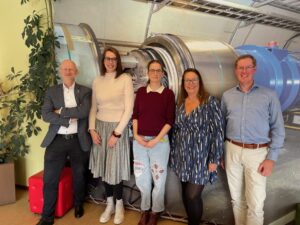
_______________________
Read more about Nikhef’s sustainability policy
Read the news article about Nikhef’s 2022 CO2 footprint report
